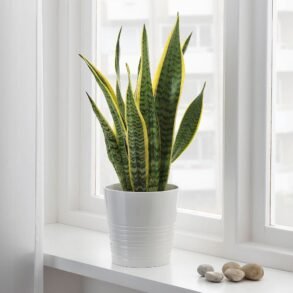Why Snake Plant is an Excellent Indoor Choice?
The Snake Plant, also known as Sansevieria or Mother-in-law’s Tongue, is one of the most dependable and stylish indoor plants. Its sharp, upright leaves and hardiness make it perfect for both modern homes and busy lifestyles. Here’s why it stands out:
-
Thrives in Low Light: Perfect for offices, bedrooms, or shaded corners
-
Needs Minimal Watering: Ideal for forgetful or busy plant parents
-
Air-Purifying Power: Removes toxins like formaldehyde and benzene (NASA Clean Air Study, 1989)
-
Unique Night Oxygen Release: Unlike most plants, it improves bedroom air while you sleep
-
Low-Maintenance: Rarely affected by pests and disease
What Makes It Visually Appealing?
Snake Plants have stiff, upright leaves that come in striking colors and patterns—like:
-
Green with silvery bands
-
Varieties with yellow edges
-
Twisted, tall, or cylindrical forms
They add a sculptural, modern touch to interiors and pair beautifully with minimalist or boho aesthetics.
Special Capabilities
-
Air Detox: Proven by NASA to filter harmful chemicals like trichloroethylene and xylene
-
CAM Photosynthesis: Converts CO₂ to oxygen at night—rare among houseplants
-
Climate-Resilient: Tolerates wide temperature ranges and dry conditions
These qualities make it especially ideal for bedrooms, small apartments, and workplaces.
Display Ideas for Modern Interiors
Create dramatic vertical lines or contrast with softer foliage by placing Snake Plants:
-
In tall, narrow pots to emphasize their height
-
In matching sets of different sizes for a bold entryway
-
In sleek ceramic, terracotta, or geometric containers for a designer look
-
Near natural light to highlight leaf texture and color
How to Repot a Snake Plant
Best Season:
-
Spring to early summer for optimal root growth
-
Morning or late afternoon is ideal for reducing stress during repotting
Tools You’ll Need:
-
New pot (with drainage holes)
-
Cactus or succulent potting mix
-
Watering can or spray bottle
-
Trowel, gloves, pruning shears
-
Tray or mat for workspace cleanliness
Pot Selection Tips:
-
Use well-draining pots (terracotta, ceramic, or plastic)
-
Choose a size just 1–2 inches wider than the current root ball
-
Ensure proper drainage to prevent rot
Condition Snake Plant’s Preference
Light Low to bright indirect light (avoid harsh direct sun)
Water Every 2–3 weeks; allow soil to fully dry between waterings
Humidity Average indoor humidity is fine
Temperature 60°F–85°F (16°C–29°C); avoid below 50°F (10°C)
Air Flow Good air circulation helps prevent rot and pests
Prevention Tips:
-
Clean leaves weekly with a damp cloth
-
Inspect new plants before adding them indoors
-
Avoid overwatering and remove dead foliage
Common Pests & Controls
Pest Symptoms Control Method
Mealybugs White cottony clusters Wipe with alcohol swab or neem oil
Spider Mites Webbing, yellow specks Mist leaves, increase humidity, use miticide
Scale Hard bumps on leaves Remove manually, apply horticultural oil
Fungus Gnats Small flies in soil Let soil dry, use sticky traps and Bt soil treatment
Common Diseases & Remedies
Issue Cause Solution
Root Rot Overwatering, poor drainage Trim roots, repot in fresh dry soil
Leaf Spot Splashing water, high humidity Remove leaves, improve airflow, apply fungicide
Soft Rot Bacterial infection Remove mushy leaves, reduce moisture
Blight Fungal/bacterial in high humidity Prune infected parts, improve air flow
Drooping Overwatering or cold drafts Adjust watering, stabilize temperature
Fertilizing Guide
-
Type: Balanced 10-10-10 or cactus fertilizer
-
Dilution: Use half-strength to avoid overfeeding
-
Frequency: Every 4–6 weeks during spring and summer
-
Organic Options: Compost tea, worm castings, fish emulsion
-
Tip: Always fertilize on moist soil and avoid leaf contact
Signs of over-fertilization include yellowing tips, slowed growth, or salt crust on soil.
Propagation Methods
1. Leaf Cuttings
-
Cut healthy leaves into 3–4 inch sections
-
Let callous over for a day or two
-
Plant the bottom edge in moist soil
2. Water Propagation
-
Place the base of a leaf in water
-
Roots appear in 4–6 weeks
-
Transfer to soil once roots are 1–2 inches long
3. Rhizome Division
-
During repotting, cut root sections with both rhizome and leaf
-
Replant each division separately
-
Fastest way to produce new, full-sized plants
Pruning & Maintenance
Task How-to
When to Prune Remove yellow/damaged leaves anytime; heavy pruning in spring
Where to Cut Snip at the base near soil line
How Much No more than 20–30% at once to avoid shock
Why Prune Keeps plant tidy, prevents disease, improves airflow
Simple Maintenance Checklist
-
Water every 2–3 weeks (less in winter)
-
Light: Low to medium indirect sunlight
-
Temperature: Keep warm and stable
-
Prune any dying leaves at the base
-
Repot every 2–3 years with fresh soil
-
Clean leaves monthly to support photosynthesis
-
Fertilize lightly only in spring and summer
-
Inspect for pests monthly
Final Thought
The Snake Plant is more than just décor—it’s clean air, calm energy, and minimalist beauty all in one. Whether you’re a beginner or a seasoned plant parent, this plant will thrive with minimal attention and offer year-round appeal.
Add effortless elegance to your space—bring home a Snake Plant today.

